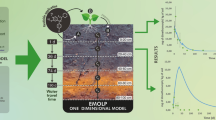Abstract
Optimal solutions found with mathematical models on agricultural chemical application depend on the interrelated complexity of the model and the required accuracy: the larger the number of complexly determined parameters, the more difficult the model. As a result, the calculation accuracy decreases. This problem should be solved with understanding of the physical aspects of the main soil processes of pesticide transport, experimental determination of their parameters, and adjustment of models in parallel with a substantiated reduction in their complexity. Experimental study of the physical processes with the PEARL 4.4.4 model and analysis of its sensitivity to the input parameters has shown which characteristics of experimental control are the most significant for water and pesticide migration. A filtration experiment with KCl made it possible to determine the dispersivity length and the filtration coefficient. As a result, a description of pesticide migration with fast water flows was introduced into the equation and the prediction accuracy increased.
Similar content being viewed by others
References
Gorbatov, V.S., Kolupaeva, V.N., Filenko, O.F., et al., Metody otsenkiekologicheskoi opasnosti pestitsidov pri ikh registratsii (Rukovodstvo po klassifikatsii ekologicheskoi opasnosti pestitsidov) (The Way to Estimate Ecological Danger of Pesticides under Their Registration. Manual on Pesticides Ecological Danger Classification), Bol’shie Vyazemy, 2010.
Kokoreva, A.A., Umarova, A.B., and Gorbatov, V.S., The way to estimate sensibility of models for matters migration in different level soils according to lysimetric flow, Vestn. Orenb. Gos. Univ., 2007, no.3.
Skvortsova, E.B., Gerke, K.M., Korost, D.V., and Abrosimov, K.N., Porous space structure in podzolic layers of sod-podzol soils (2D-and 3D images analysis), Byull. Pochv. Inst. im. V.V. Dokuchaeva, 2013, no.71.
Smetnik, A.A., Spiridonov, Yu.Ya., and Shein, E.V., Migratsiya pestitsidov v pochvakh (Pesticides Migration in Soils), Moscow, 2005.
Teorii i metody fiziki pochv (Soil Physics: Theory and Methods), Shein, E.V. and Karapachevskii, L.O., Eds., Moscow, 2007.
Umarova, A.B., Preimushchestvennye potoki vlagi v pochvakh: zakonomernosti formirovaniya i znachenie v funktsionirovanii pochv (The Main Water Flows in Soils: Formation Regularities and Mean in Soils Functioning)), Moscow, 2011.
Shein, E.V., Physically based mathematical models in soil science: history, current state, problems, and outlook (analytical review), Eurasian Soil Sci., 2015, vol. 48, no. 7, p.712.
Shein, E.V., Kokoreva, A.A., Gorbatov, V.S., et al., Sensitivity assessment, adjustment, and comparison of mathematical models describing the migration of pesticides in soil using lysimetric data, Eurasian Soil Sci., 2009, vol. 42, no. 7, p.769.
Boesten, J.J.T.I., Influence of dispersion length on leaching calculated with PEARL, PELMO and PRZM for FOCUS groundwater scenarios, Pesticide Manage. Sci., 2004, vol. 60, no. 10, pp. 971–980.
Conclusion on the peer review of the pesticide risk assessment of the active substance cyantraniliprole, EFSA J., 2014, vol. 12, no.9.
Dubus, I., Brown, C., and Beulke, S., Sensitivity analysis for four pesticide leaching models, Pesticide Manage. Sci., 2003, vol. 59, no. 9, pp. 962–982.
FOCUS. Generic Guidance for Tier 1 FOCUS Ground Water Assessments, 2014.
FOCUS. Leaching Models and EU Registration, European Commission Document, 1995, no. 4952/VI.
van Genuchten, M.Th., CFITIM Model: Estimates Parameters in Several Equilibrium and Non-Equilibrium Transport Models from Solute Breakthrough Curves, Riverside, 1981.
van Genuchten, M.Th., Leij, F.J., and Yates, S.R., The RETC Code for Quantifying the Hydraulic Functions of Unsaturated Soils, Riverside: US Salinity Lab., 1991.
Jarvis, N.J., Brown, C.D., and Granitza, E., Sources of error in model predictions of pesticide leaching: a case study using the MACRO model, Agric. Water Manag., 2000, vol. 44, no. 1–3, pp. 247–262.
Katagi, T., Soil column leaching of pesticides, Rev. Environ. Contam. Toxicol., 2013, vol. 221, pp. 1–105.
Kördel, W. and Klein, M., Prediction of leaching and groundwater contamination by pesticides, Pure Appl. Chem., 2006, vol. 78, no.5.
Merdun, H. and Quisenberry, V.L., Evaluation of MACRO model by short-term water and solute transport simulation in Maury silt loam soil, Plant, Soil Environ., 2005, vol. 51, no.3.
Modelling of Environmental Chemical Exposure and Risk, J.B.H.J. Linders, Ed., Wageningen, 2001.
OECD Guidelines for the Testing of Chemicals, Leaching in Soil Colums, Paris, 2004.
Prado, H.A., Luiz, A.J.B., and Filho, H.C., Computational methods for agricultural research: advances and applications, Hershey: Inf. Sci. Ref., 2011.
PSD Pesticide Data Requirement Handbook, London, 2005.
Scorza, R.P.J. and Silva, P., Sensibility analysis of the pearl model for pesticide leaching in the State of Mato Grosso do Sul, Brazil, Rev. Eng. Agric., 2011, vol. 31, no.5.
Scorza, R.P.J. and Boesten, J.J.T.I., Simulation of pesticide leaching in a cracking clay soil with the PEARL mode, Pesticide Manage. Sci., 2003, vol. 61, no. 5, pp. 432–438.
Tiktak, A., Hendriks, R.F.A., and Boesten, J.J.T.I., Simulation of movement of pesticides towards drains with a preferential flow version of PEARL, Pesticide Manage. Sci., 2011, vol. 68, no. 2, pp. 290–302.
Tiktak, A., van den Berg, F., Boesten, J.J.T.I., et al., Manual of FOCUS PEARL Version 1.1.1, Wageningen, 2000.
Author information
Authors and Affiliations
Corresponding author
Additional information
Original Russian Text © E.V. Shein, A.A. Belik, A.A. Kokoreva, V.N. Kolupaeva, P.A. Pletenev, 2017, published in Vestnik Moskovskogo Universiteta, Seriya 17: Pochvovedenie, 2017, No. 4, pp. 45–51.
About this article
Cite this article
Shein, E.V., Belik, A.A., Kokoreva, A.A. et al. Prediction of pesticide migration in soils: The role of experimental soil control. Moscow Univ. Soil Sci. Bull. 72, 185–190 (2017). https://doi.org/10.3103/S0147687417040044
Received:
Published:
Issue Date:
DOI: https://doi.org/10.3103/S0147687417040044




